I reached the age of eighteen on the 22 December 1940, and enlisted
in the army in early January 1941, choosing to join The Kings Royal
Rifle Corps, 70th Young Soldiers Battalion. During this early period
of the war we were defending airfields in South East England, expecting
the Germans to launch an invasion of the country at any moment. However,
fortunately for us, no invasion occurred. This was Hitler’s greatest
mistake that was to cost him victory, as had he invaded England in 1941
we would have had nothing to stop him with.
In the early months of 1942, I volunteered to join the newly formed
Airborne Forces. On the 26 May 1942 I was posted to Wing Barracks, Bulford
Camp, Wiltshire. There I joined “D” Company of the 2nd Battalion
Oxfordshire and Buckinghamshire Light Infantry. This company was commanded
by Major R. J Howard.
The major turned out to be a very hard and tough taskmaster with expectation
of the highest standards from those he commanded. He was “The
Boss”, but his training routine produced a company that was second
to none in the British Army. Our main mode of transport was army boots.
In other words, we marched everywhere. If you did not make the grade,
“D” company was not good for your health. The company consisted
of four platoons, No's 22, 23, 24 and 25, with 28 men in each platoon;
plus company H.Q.

Replica Horsa - Pegasus Museum Benouville
On the 2 May 1944, the company assembled in 22 platoons’ room
to listen a talk by Major Howard. Firstly we were sworn to secrecy on
what was about to be revealed to us that day, that the re-entry into
Europe was to happen very soon, within weeks. Our task in the invasion
of Europe was to capture two bridges at night. There was to be a period
of special training starting that very day after the meeting. From that
moment in time the bridges' task took full control of our lives. In
the next few weeks we captured many “make-believe” bridges.
Meanwhile, two bridges located in Devon, similar to the bridges we were
training to capture where found. So we moved to the Exeter region and
spent three days and nights of intensive training on these two bridges.
Our very lives depended on the practice. We then returned to our base
at Bulford.
On the 26 May 1944, “D” Company was moved to a sealed concentration
area on the fringe of Tarrant Rushton Airfield. Once safely within this
area we undertook more training on taped out bridges. We were joined
by two extra platoons, No’s 14 and 17 from “B” Company,
30 Royal Engineers and 12 pilots from the Glider Pilot Regiment, plus
one Doctor. The gear was assembled whilst we trained and relaxed awaiting
the final briefing.
1st June 1944:
On the afternoon of the 1st June 1944, 24 platoon, of which I was a
member, and commanded by Lt David Wood were marched into the briefing
room which was kept locked and an armed guard posted at the door. Major
Howard was inside. We received the details, it was to be Normandy, the
target : 2 bridges on the Caen canal and River Orne were to be captured
intact and held until relieved. Platoons 24, 25 and 14 were to capture
the canal bridge. Platoons 22, 23 and 17 were to take the Orne Bridge.
We studied a very accurate sand table model, read whatever information
was available, books, maps, papers and photos. Major Howard answered
questions on the bridges and the method of attack. The first platoon
to land would rush straight across the bridge to secure the western
end around the Café Gondrée. The second platoon down would
clear the enemy from the north-eastern bank of the Canal. The third
Horsa to land had the task of crossing over to the west bank of the
canal to reinforce the first platoon. That was the laid down plan of
action for the canal bridge attack. With regard to the Orne river bridge,
no doubt a like plan of action was in operation. But as I was not involved
in that part of the operation I cannot make any pre-raid comment. With
further regard to the canal bridge attack, at the briefing by Major
Howard, we were certain that if the gliders put us down in the right
position we could take our bridge but the question of holding it against
strong enemy tank counterattacks was going to be a problem. The major’s
reply to this was “We must hold them”, so that answered
the question. It was now just a question of waiting for the weather
to improve. Each Horsa Glider would carry 2 pilots, 5 Royal Engineers,
23 airborne infantry making 30 men in each glider. 6 Horsa's were to
land a 180 men in total.
4th June 1944:
The morning of the 4 June, we awoke to the sound of strong
winds and heavy rain beating down against the canvas of our seven man
tents. No gliders would take off in these kind of weather conditions.
That evening some kind soul laid on a film; it had a rather apt title
“Stormy Weather” an American Musical. By the end of the
day the winds had died down and the heavy rain had ceased. We retired
to our tents, not knowing what the new day would bring. We talked into
the early hours and one by one drifted to sleep.
5th June 1944:
As day dawned a shower or two came down during the morning, nothing
was certain. This was not good for our nerves. Throughout Britain, a
million or more men were waiting to go into action. We, in our small
encampment, knew that our small party were to be the very first allied
troops to land in France. Our nerves were being stretched to the limit
by this constant waiting. Around midday, a signal arrived for Major
Howard. The company were assembled and the major informed us that it
would be tonight. A padre arrived and a short but solemn service was
held. Major Howard gave the order to have lunch, check all our weapons
and gear down to the last detail then when all of this was completed
to try and get a few hours of sleep. Under the circumstances of stress
and strain, this was a tall order indeed. However, I did manage to fall
into a deep sleep. We were awakened in the early evening, had a meal
and conducted kit check. The order to don our gear came, we climbed
into the troop carrying vehicles, and were driven off as dark began
to fall. It was just a short run to Tarrant Rushton Airfield. As we
passed the administration area, crowds of RAF men and women were cheering
us. So much for security I thought, everyone knew what we are about
to do. We drove direct to our six Horsa gliders and sat down on the
grass beside them. The time was about 22h00.

Harry and L/Sgt Raymond 'Titch' Rayner
We learnt from one of the RAF ground crew that we were
due to take off at 23h00. The weather was dry, with the odd gust of
wind but nothing to worry about. Around 22h20, an RAF chap appeared
on the scene with a Dixie of very strong tea that was well laced with
rum. That tea certainly calmed my nerves in rapid time. At around 22h30
our two glider pilots appeared. Both were staff sergeants, Oliver Boland
and Phil Hobbs. Shortly after the order came to board the Horsa glider,
I was seated on the front side of the Horsa in the fourth seat from
the door. Some ten minutes before take off, Major Howard appeared in
the doorway of the glider and he made a short impromptu speech thanking
us for our past efforts and wishing us well on the mission we were about
to embark upon. His voice rang out with a final “Good luck to
you all”. Just before 23h00 we heard the first Halifax-Horsa combination
roar along the runway. They were airborne at 22h59m20s. The other five
Horsa’s followed at one-minute intervals. I was in N° 92 Horsa.
Horsa glider N° 92 carried 24 platoon commanded by Lt David Wood,
mainly young men going into action for the first time. Tonight would
be a testing time but I had trained with those men over the last two
years and had no doubts as to their ability. Inside the glider the men
sat in a strained silence. For all in 24 it was their first night flight,
apart from the two pilots who had done much night flying in training
for this operation. After ten minutes or so, voices rose in song that
did much to uplift our spirits. After take off, the Halifax-Horsa combination
flew at 4500 feet because of low cloud. The pre-flight-altitude was
planned at 6,000 feet. The first leg of the flight was Worthy Down close
to Winchester, then a change of course to Bognor Regis on the South
Coast. It was a fairly smooth flight with the troops singing most of
the time. At the shout of “enemy coast ahead”, the silence
became total. We had been flying for 1h 15. The glider released its
towrope at 00h17.30 about a mile from Normandy coast midway between
the Rivers Orne and Dives.
The silence was broken by the sound of air rushing across the huge wings
of the Horsa glider as it surged towards its landing. A sudden shout
from one of the glider pilots “Brace for impact”; we linked
our hands and raised our feet and no doubt said a silent prayer. The
Horsa hit the ground and bushes, bounced, and then stopped. The passengers
were propelled through either the side of the Horsa or the open front
exit. We very swiftly formed up at the nose of the Horsa and at a word
of command from Lt Wood began to trot towards the bridge some one hundred
or so yards to our front. As we reached the eastern end of the bridge
a flare lit up the area. Some thirty or so yards from the bridge lay
the wreck of a Horsa, its two pilots trapped in the cockpit. By the
light of the flare we could see our troops running across the canal
bridge, firing as they ran. Lt Wood located Major Howard who ordered
our platoon to clear the enemy from the pillbox and trenches on the
North Eastern bank of the canal.

Manning of the Bridge Gun
(Sketch by Malcolm Winter)
We very swiftly carried out this order. In perhaps six or seven minutes,
we had routed the enemy. Lt Wood was on his way to Major Howard to report
all cleared when he, the platoon sergeant and radio operator were hit
by a burst of automatic fire. Corporal Godbold reported to John Howard
who in turn gave him command of the platoon and he in turn gave the
Type 38 radio set to me. We had captured our bridge. The third glider,No.93,
had landed shortly after our Horsa, one man drowned in the pond, several
men were injured including Lt Smith who had injured his wrist, whilst
one of the glider pilots, Geff Barkway, was later wounded after failing
to respond to a password challenge. The remainder of the platoon were
sent over to reinforce 25 platoon on the west bank. Lt Dan Brotheridge,
25 platoon commander, had received a burst of fire in his neck and was
dying. The injured Lt Smith took over command of 25 and 14 platoons
who were now holding the western end of the bridge in the region close
to the café Gondree.

In the meantime word arrived that two gliders had landed
and captured the River Orne bridge. 22 platoon Horsa was missing, fate
unknown at that time, though later we found out that they had captured
a bridge over the River Dives due to a navigational error. However,
with one glider astray this left us with about one hundred and thirty
five men to defend the two bridges until our relief came
About 00h45 we heard the drone of many aircraft approaching and within
minutes the 5th Parachute Brigade began its drop. The 7th Parachute
Battalion was to rush to our aid with all speed, but a scattered drop
caused many problems and also a strong wind blew many away from their
DZ.
Around 01h00 the sound of tanks was heard in the Le Port area. As the
first one began to edge onto the road leading to the bridge Sergeant
“Wagger” Thornton hit it with a missile from his PIAT, a
rather primitive anti-tank weapon. It exploded like a firework display
blocking the road. Sometime around 03h00 a large number of 7th Para
arrived to reinforce our depleted force.
As dawn broke we readied ourselves in expectation of heavy counter attacks
from infantry and tanks, however, these failed to appear. The German
High Command was seemingly in a state of disorder and failed to realise
the importance of the bridges. The sound of naval bombardment on the
beaches reminded us that the sea borne troops were coming ashore, whilst
intense sniper fire began to cause a number of casualties among our
troops. Later in the morning the Division received support from the
navy, 16 inch shells passed over our heads with a deafening roar.
.....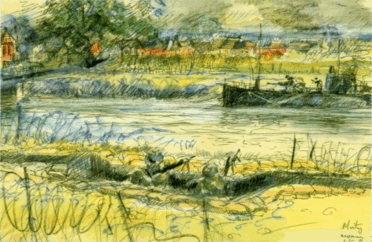 . .
Capture of Patrol Boat
(Sketch by Malcolm Winter)
Later during the morning a German patrol boat was spotted
coming from the direction of the coast. When it was some 200 yards away
Corporal Godbold, Pete Cheesely and myself ran with a PIAT to some cover
on the canal bank. We kept a close eye on the boat, and whilst there
was little sign of life, the engine was ticking over and someone appeared
to be steering it. At about 50 yards range Corporal Godbold fired a
PIAT grenade at the boat. It struck it just behind the wheelhouse and
exploded internally. The boat drifted into the canal bank and two very
frightened Germans emerged from below deck. John Howard ordered me to
march them down to the 5th Para Brigade Headquarters, at Ranville, along
a stretch of road exposed to enemy snipers. As we approached the Orne
Bridge we came under fire. Like myself the prisoners were reluctant
to cross, yet it had to be done. After a short dash we arrived at Brigade
Headquarters and I handed the two prisoners over to an MP Sergeant.
I was able to return to my company without incident.
 ---- ----
Harry Clark with Arlette Gondree.........................Col.
Arata: US Rangers - West Point Instructor giving Harry a West Point
Medallion
Later the sound of battle from the beaches became more
prominent. Word came through that the leading elements of the Commando
Brigade were in the vicinity, and shortly after 13h00 the sound of bagpipes
could be heard and Lord Lovat with his piper, Bill Millin, crossed the
canal bridge. As the brigade crossed the bridge a number were felled
by very accurate sniper fire. We had assumed a defensive position around
the bridges that gave us a wonderful view of the 6th Air Landing Brigades’
Gliders coming over during the evening. We were eventually relieved
by troops of the 3rd Division just before midnight on the 6 June. For
“D” Company of the 52nd it had been the Longest Day. We
had captured and held our two bridges in an attack that is now a part
of history.
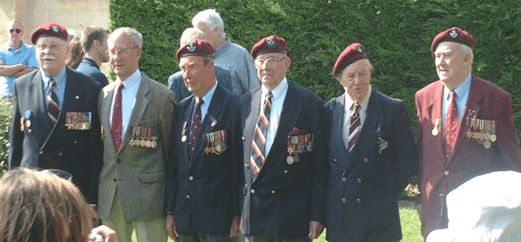
Left to Right, - This picture taken at Ranville Cemetery
opposite Lt. Dan Brotheridge grave.
Lt. David Wood, Pte William Gray, L/Cpl Thomas Packwood,
Sgt Raymond Rayner (Titch,
Pte Harry Clark (Nobby), Pte Arthur Roberts
Harry died in 2008
Copyright: Text & Images - Harry Clark
E mail
to: Jim Clark (Harry's son.)
Back to: Service
Stories
Back to: Home Page
|
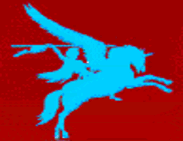
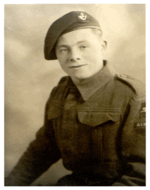
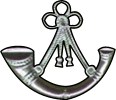




 .
. ----
----
